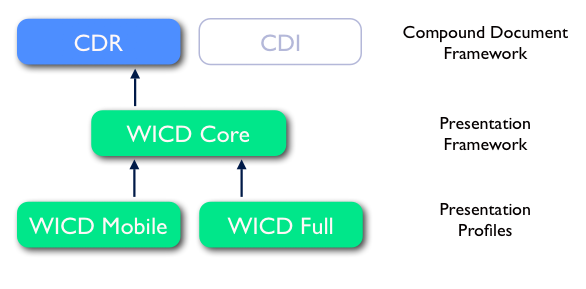1 Introduction
(This section is informative)
The WICD Full 1.0 profile is designed to enable
rich multimedia content on desktop and high capability handheld agents.
These are agents with:
- wide screens (supporting more than 40 characters per line)
- a pointing device
1.1 Scope
User agents, conformant to the WICD Full 1.0 profile,
must also implement:
WICD Full 1.0 is a superset of
WICD Mobile 1.0.
The image below shows the relation between WICD and CDF documents.

2 Document Formats
2.1 XHTML 1.1
Comformant WICD Full 1.0 user agents must support
XHTML 1.1 - Module-based XHTML
as root document.
2.1.1 XHTML MIME Type
XHTML documents authored for the WICD Full 1.0 profile should be associated with the "application/xhtml+xml" mime type.
2.2 ECMAScript 3rd Edition
Conformant WICD Full 1.0 user agents
must support ECMAScript 3rd
Edition as a scripting language.
2.2.1 ECMAScript MIME Type
ECMAScript documents authored for the WICD Full 1.0 profile should be associated with the "application/ecmascript" mime type.
2.5 Bitmap formats
The comformant user agent must support JPEG/JFIF [JPEG][JFIF] and PNG [PNG] raster
image formats. Other image formats may be supported in addition. For
JPEG, the subset defined in [SVG12] SHALL be supported. For PNG, all
color types and bit depths SHALL be supported, gamma correction
SHALL be supported, and any alpha or transparency information SHALL be
used to composite the image onto the background.
2.6 Audio formats
Audio may be incorporated into WICD Full 1.0 content in several ways. It may
be pointed to from an XHTML object element, or an SVG audio element, or
indirectly from an SVG video element where the video includes audio.
In XHTML, there are no timing elements. Thus, audio will play from the
time the document is loaded until the time the document is unloaded (eg,
replaced by another document as a result of following a link). In
conforming WICD Full 1.0 content, audio referenced from an XHTML object
element must have width and height of zero.
In SVG, audio may be triggered by user interaction or by animations to
start, stop, or change volume.
For accessibility, conforming WICD Full 1.0 user agents should profile the
option of switching off audio. [UAAG].
Some audio formats may be mandated in this profile.
Any audio format supported by the device must also be supported
to be used with the <audio> element in SVG and <object> element in XHTML.
2.7 Video formats
Video may be incorporated into WICD Full 1.0 content in several
ways. It may be pointed to from an XHTML object element,
or an SVG video element.
In XHTML, there are no timing elements. Thus, video will
play from the time the document is loaded until the time
the document is unloaded (eg, replaced by another document
as a result of following a link).
In SVG, video may be triggered by user interaction or by
animations to start, pause, rewind, or stop.
For accessibility, conforming WICD Full 1.0 user agents must
provide the option of pausing, rewinding, or stopping
video.
Some video formats may be mandated in this profile.
Any video format supported by the device must also be supported
to be used with the <video> element in SVG and <object> element in XHTML.
